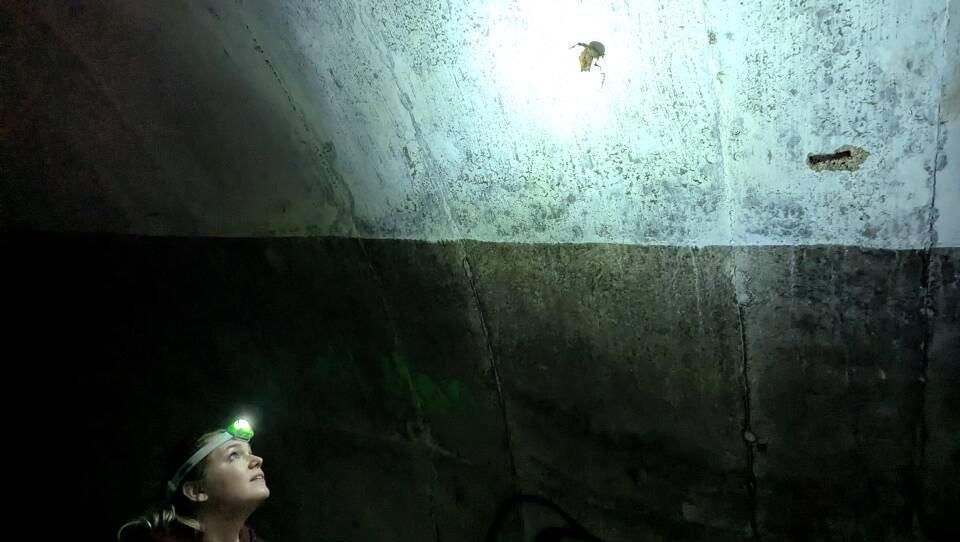Massachusetts biologist Elise Stanmyer scrambled into the dark of an abandoned World War II military building. She whispered so she wouldn’t wake its winged residents.
Her headlamp illuminated one lone bat that clung to the wall. It could be the tricolored bat, or perhaps a species known as the little brown — both endangered in Massachusetts.
“It’s hard to tell,” she admitted. “One thing we look at to determine little brown bats is how long their toe hairs are.”
Stanmyer works for the Massachusetts Department of Conservation and Recreation. Part of her job involves monitoring the nine bat species found in the Bay State.
On this October day, she’s setting up a bat detector, an acoustic device to record bat calls at sunrise and sunset. Later, she’ll run those vocalizations through a software to identify what bat species are using this human-made cave, now adorned with graffiti and littered with rubber tires and empty cans.
DCR requested that GBH News conceal the exact location of this roost to protect the endangered species there.

The goal is to learn more about how climate change could be shifting bat activity in this place, the largest known bat hibernation spot in the state. Protecting over-winter habitats is crucial for these important mammals that have seen drastic population declines this century.
“There’s been a lot of reports lately that some of these coastal bats, especially like the northern long-eared bat, are going into hibernation a lot later than we would expect,” she said.
Bats mate in the fall. But if they’re pushing mating later in the season, the DCR may shift when it does certain activities, like tree removal, to avoid disturbing them, Stanymer said.
Acoustic data collected at this site will also be submitted to the North American Bat Monitoring Project database, which the federal government uses to help shape national management practices.
Despite their scary reputation, most bats — including all of the species in Massachusetts — don’t suck blood.
“They’re so cool. They’re cute. They’re great for the environment,” said Laura Hancock, a bat researcher at Massachusetts College of Liberal Arts.
Instead, they gorge on insects and can eat half their bodyweight in bugs nightly. That makes bats super valuable, Hancock said.
“They’re very important in terms of reducing pests. Agricultural pests, pests that we as humans don’t like,” she said. “It has a massive economic impact in terms of helping farmers ... so that we don’t have to spend money managing those pests.”
The pesticide DDT wiped out insects that bats used for food in the 1960s and ’70s. But bats made a recovery once the pesticide was banned. Then, in the early 2000s, a fungal condition called white nose syndrome devastated several species of bats.
“Places that might have had 10,000 bats and now have eight total bats. ... It’s that drastic of a drop,” said MassWildlife biologist Nathan Buckhout, who periodically does bat population surveys in Western Massachusetts.
In Chester, Mass., a hibernation cave used to house 10,000 bats. In just one year, only 14 bats remained — the rest had been killed by the fungus. That population has started to slowly recover, according to Massachusetts Division of Fisheries and Wildlife.
White nose syndrome killed over 90% of three North American species in under a decade, according to one study.
Hibernating bats — the majority of species here — are more susceptible to white nose syndrome.
The fungus thrives in the damp, cool environments of caves, abandoned mines and other structures that bats use to wait out the winter months — like the decommissioned military building. The fungus grows on their faces and aggravates them, waking them from hibernation. Bats then expend too much energy, and starve to death.
At its peak, the biggest hibernation site in the state houses almost 200 bats, but Stanmyer said she’d like to see more.
“This should be like, chock full,” she said.
Bats also get a bad rap for being rabies vectors. Like many mammals, they can carry rabies, but it’s very rare.
“Less than 1% of bats, so about half a percent, have rabies,” Hancock said.
But for those who do have a bat encounter, it’s still a good idea to check with a doctor, MassWildlife’s Buckhout advised.
Citizen efforts
Most bats will begin their hibernation or southern migration over the next few weeks. Everyday citizens can help conservation efforts year-round by building bat houses or turning their yards into attractive bat habitats.
To tap into the Halloween season, people can look for these flying mammals at dusk near ponds or open fields before they hunker down for the winter and report bat sightings to MassWildlife.
“The Halloween stuff is great, but ... people think bats are spooky or ... they’re an icky creature,” said Buckhout. “I just want people to give them a chance ... realize how good they are.”








